The second interstellar travel object to the Solar System
The researchers concluded that a 20km diameter comet could come from outside the solar system based on its unusual orbit.
Asteroid center (MPC) at Harvard University discovered comets suspected to be the second interstellar object after the elongated object 'Oumuamua was identified in 2017. The new object is called comet C / 2019 Q4 (Borisov) appears to have hyperbolic curve trajectory, revealing its origins from its other planetary system.

The newly discovered comet has a hyperbolic orbit with high eccentricity.(Photo: BBC).
The hyperbolic orbit is eccentric. A perfect circle has an eccentricity of 0. The elliptical orbits of many planets, asteroids and comets have eccentricities between 0 and 1. Comet C / 2019 Q4 (Borisov) has a deviation The mind is 3.2 based on current observations.
Amateur observer Gennady Borisov noticed this comet on August 30 at the Crimea Astrophysical Observatory in Bakhchysarai. At that time, C / 2019 Q4 (Borisov) was three astronomical units from the Sun (about 450 million km).
'Oumuamua, discovered on October 19, 2017, was originally classified as a comet based on its hyperbolic flight path. But subsequent observations found no sign of coma, the gas surrounding the comet core. In contrast, C / 2019 Q4 (Borisov) is a working comet with coma and the tail is clearly visible.
Unlike the small and dim 'Oumuamua', C / 2019 Q4 (Borisov) seems quite large, 20km wide and very bright. 'Oumuamua is monitored after it is closest to the Sun (near-perpendicular), so the results of the observations are not clear enough for astronomers to answer many questions. However, C / 2019 Q4 (Borisov) is still approaching the Solar System and will not reach its perihelion by September 10.
The Asteroid Center calls on astronomers to continue observing the object for at least 12 months. This discovery gives them an interesting opportunity to learn about the characteristics of objects that are more likely to come from distant stars.
- The first interstellar object in the solar system 4.5 billion years
- The violent past of interstellar travel objects visited the solar system
- The intense past of interstellar traveling objects visits the solar system
- The latest messages from interstellar travel objects that we observe
- The first interstellar object in the solar system 4.5 billion years
- Interstellar material
- The mysterious factor for the journey to the interstellar environment
- Interstellar objects like cigarettes' Oumuamua is considered a comet
- For the first time, identify an object from outside the Solar System
- Can interstellar dust create the Solar System?
- Voyager 2 leaves the Solar System, enters the interstellar realm
- When can humans set foot outside the solar system?
- Spacecraft can fly forever without fuel thanks to this
- The universe outside the solar system is different from what we think
 Van Allen's belt and evidence that the Apollo 11 mission to the Moon was myth
Van Allen's belt and evidence that the Apollo 11 mission to the Moon was myth The levels of civilization in the universe (Kardashev scale)
The levels of civilization in the universe (Kardashev scale) Today Mars, the sun and the Earth are aligned
Today Mars, the sun and the Earth are aligned The Amazon owner announced a secret plan to build a space base for thousands of people
The Amazon owner announced a secret plan to build a space base for thousands of people